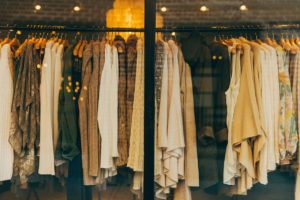The Sad Truth About Cheap Clothing
By Emily Powell
As a college-age millennial female, I try to keep my fashion choices moderately updated. But with a tiny monthly budget resulting from typical college-kid expenses (e.g. textbooks and ramen noodles), my disposable income is minimal, leaving me little room to make the most of fashion with small amounts of cash. Enter the holy grail of modern, affordable, “fast fashion”: Forever 21 and H&M.
I remember the first time I walked into a Forever 21, baffled by the color and style coordination of their displays and gawking at the unbelievably cheap price tags. I was starry-eyed and more excited than I would ever care to admit. These stores have mastered the art of the “catch-all” retail therapy, where anyone and everyone can flock to buy a t-shirt for less than $5 or a blazer for $12.90. Leaving Forever 21 or H&M with a plastic bag full of cheap polyester blouses and plastic jewelry made me smugly satisfied, like I’d just cheated the system on some screaming deal. That was before I’d really opened my eyes or started asking important questions about the exact origins of that fabric or the impossibility of trading a few dollars for a piece of clothing that had travelled an impossibly complex supply chain to arrive in my closet.
The clothing industry is magical. Not only do brands and retailers succeed in isolating you from the origins of their products, but they do so in a way that makes you believe you don’t need to know where this shirt or these pants came from. They’re right here right in front of you right now (and they’re 30% off!!?!!!) and that’s all that matters.
In reality, however, there are very good odds that any article of clothing you see in “fast fashion” retailers was made by a female worker under the age of 15 in a muggy, dark, ill-ventilated factory in a third-world city such as Bangladesh. With such low price points, “fast fashion” retailers rely on high volume sales to make profit, therefore the clothing needs to be made cheaply and efficiently, often in cities and countries that have minimally-enforced minimum wage policies where labor is cheapest. In essence, as The Guardian explains, “fast fashion has engendered a race to the bottom, pushing companies to find ever-cheaper sources of labor. That cheap labor is freely available in many of the countries where textile and garment production takes place.”
The eye-opening documentary True Cost made by Andrew Morgan exposed me to the actual realities of what goes into the cheap, disposable clothes we buy, and it’s not pretty. In order to produce the huge quotas set by fast fashion giants—which, by the way, are 400% higher than they were 20 years ago—“97 percent [of textile production] is outsourced to poor countries where factory owners compete for prices on contracts and regulation is lax” (stated in the film and quoted on the Business Insider website). Also in the film, Livia Firth explains her first experience in a typical textile factory on a mission with OXFAM as “gut-wrenching.” The run-down, three-story building which is guarded by a security officer holds floors of sewing machines, packed with women who are forced to work 12- or 14-hour days with two bathroom breaks and minimal pay. This is the reality of fast fashion.
So why is this the case? Well, as Neil Saunders, the managing director of retail marketing consulting firm Conlumino explains, “in commercial terms, ethics don’t make a difference. Young consumers will lean away from corporate and social responsibility when price is factored in.” Even if consumers were educated about the unethical horrors behind the supply chain of the clothing they buy (which is rare, considering that most retailers cannot even trace their supply chains due to complex and obscure sub-contracting), the lure of a cheap price is attractive enough to make all understanding of sustainable fashion irrelevant. But every purchase is a vote with your money, and even though it may be unbelievably satisfying to get six new outfits for under $100, we all have a responsibility to shop for what we see behind the tag.
Solving social justice issues caused by mass-produced garments involves taking the initiative to “slow down the endless treadmill of buying disposable, cheap clothing,” says True Cost filmmaker Andrew Morgan. This means shopping less (or not at all) at cheap garment stores and supporting businesses that are certified or verified as fair-trade or socially responsible. Most of these businesses are committed to transparent supply chains, fair wages, and/or other training and schooling programs for the communities that house their factories. A complete list of such retailers can be found at The Good Trade site linked at the bottom of this article. As the constituents of a largely impactful consumer base, we have the influence to change the demands of the fashion industry. We have the will and the income to choose which systems we support and which need to be eradicated. We have the power to improve the livelihoods of workers in third-world factories, and it’s time we put it to good use.
“The Good Trade”: 35 fair trade and ethical clothing brands that are betting against fast fashion
 Emily’s exuberant passion for sustainability and sustainable nutrition stems from her everlasting love for the outdoors, people, dirt, and broccoli. As an undergraduate in the School of Sustainability at Arizona State University, Emily is working towards becoming a spokesperson for everyday sustainable food and lifestyle choices, including decisions on what foods you buy, where you buy them, and how you make the most of foods’ energy. Leveraging communication through writing, Emily has been recognized in competitions such as the DuPont Challenge and the Apprentice Ecologist Initiative for her essays on sustainability issues and initiatives, including Honeybee Colony Collapse Disorder and community gardens in elementary schools. Emily aspires to utilize relationships with other academic disciplines to plant the seeds of sustainability and nutrition principles in the young adults of her generation. She plans to earn her Registered Dietitian credential and work either on the community or personalized sustainable nutrition level.
Emily’s exuberant passion for sustainability and sustainable nutrition stems from her everlasting love for the outdoors, people, dirt, and broccoli. As an undergraduate in the School of Sustainability at Arizona State University, Emily is working towards becoming a spokesperson for everyday sustainable food and lifestyle choices, including decisions on what foods you buy, where you buy them, and how you make the most of foods’ energy. Leveraging communication through writing, Emily has been recognized in competitions such as the DuPont Challenge and the Apprentice Ecologist Initiative for her essays on sustainability issues and initiatives, including Honeybee Colony Collapse Disorder and community gardens in elementary schools. Emily aspires to utilize relationships with other academic disciplines to plant the seeds of sustainability and nutrition principles in the young adults of her generation. She plans to earn her Registered Dietitian credential and work either on the community or personalized sustainable nutrition level.
*Disclosure:
Some of the links in our podcast show notes and blog posts are affiliate links and if you go through them to make a purchase, we will earn a nominal commission at no cost to you. We offer links to items recommended by our podcast guests and guest writers as a service to our audience and these items are not selected because of the commission we receive from your purchases. We know the decision is yours, and whether you decide to buy something is completely up to you.








During one of my rare trips to the mall, I found this amazing top on sale. As I layed it down on the counter to pay, the country it was made in jumped out at me, and my stomach wrenched. I had recently read an article about the abusive practices towards women involving slave labor and forced prostitution taking place there. I told the clerk I was unable to purchase the item due to these conditions. This incident forever altered my shopping practices, turning me into a fully educated buyer that I may avoid supporting worker exploitation on any level. Ninety-nine percent of the clothing bought today comes from resale shops; love the idea of ‘recycling.’ And my daughters have followed suit on this one! Thank you for this informative article.
I refuse to buy from communist nations- the abuse on peoole is diobolocal and i cant support it.
Best to buy from your own nation: supporting local workers, future job growth and steady taxes from goods sold.
I’ve also read that these sweat shops, while truly awful places, are sometimes the only employment standing between these women and prostitution. I would take a sweat shop job myself over prostitution any day. Is there any truth to that?